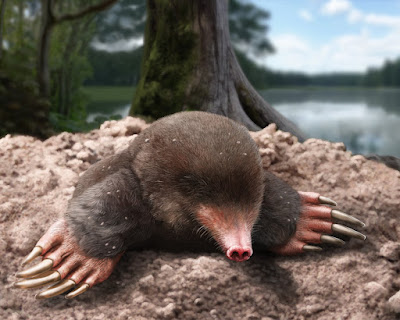 |
| Vulcanoscaptor ninoti Linares-Martín, 2025, in Linares-Martín, Furió, Gómez de Soler, Agustí, Oms, Grandi, Blain, Moreno-Ribas, Piñero et Campeny, 2025 Artwork by Jesús Gamarra / IPHES-CERCA |
Abstract
The Pliocene Konservat-Lagerstätten maar lake site of Camp dels Ninots (NE Iberian Peninsula) has recently delivered a partial skeleton of a mole (family Talpidae) with many elements in anatomical connection. At a first glance, molar and humerus size, geological time interval, and geographical location suggested that this specimen could correspond to Talpa minor. However, after some mechanical preparation of the clay block (matrix removal, consolidation, and cleaning) and a micro-CT scan, this excellently preserved specimen turned out to be an unknown species to science. The resulting 3D models of this new form, Vulcanoscaptor ninoti gen. et sp. nov., revealed some peculiar morphological traits in teeth, mandible, and postcranial elements, which according to the phylogenetic analysis carried out, would allocate this new species within the tribe Scalopini. This is surprising, because the closest relatives of the new species within this tribe live nowadays in North America, and only some related taxa had been previously reported in the Oligocene and Miocene fossil record from Europe. The postcranial construction of this specimen reveals a highly fossorial lifestyle supported by a complex forelimb structure. How such a specialized digging animal reached the maar lake sediments where it was finally preserved is still to be solved. Some hypotheses consider swimming abilities for this extinct species. Alternatively, this specimen could be the remaining portions of a floated or scavenged carcass whose remains fell into the lake and reached the anoxic bottom.
Keywords: Camp dels Ninots, Maar, Konservat-Lagerstätten, Spain, Fossorial
 |
| Partial skeleton of Vulcanoscaptor ninoti gen. et sp. nov. (CN10-O17-NIV11-12) |
Vulcanoscaptor ninoti gen. et sp. nov.
Diagnosis (genus and species). [No trait alone is diagnostic, but the combination of characters is unique within the Talpidae] Small sized mole with dental formula ???3/2143. Doubled mesostyle in M1 and M2. Double rooted P4. Presence of a parastyle in P4. Lower premolar row without gaps. Enlarged i2. Absence of metastylid in m2. Robust and small postcranial remains. Pit for M. flexor digitorum profundus ligament present. Straight medial edge of humeral trochlea. Fusiform shape of the humeral capitulum. Well-developed and transverse olecranon crest. Anconal and coronoid processes present in the ulna. Presence of capitular process in the radius. Scaphoid and lunar not co-ossified.
Etymology. Name of the genus derived from the Latin word of ‘Vulcan’, the Roman god of fire, in reference to the volcanic nature of the source area, and ‘-scaptor’, from the ancient Greek word ‘scaptein’, to dig. Name of the species invoking ‘ninot’, the local word to refer the opaline nodules ‘doll-shaped’ typically found in the type-locality of the species, Camp dels Ninots.
 |
| Realistic reconstruction of Vulcanoscaptor ninoti. Artwork by Jesús Gamarra / IPHES-CERCA |
Adriana Linares-Martín, Marc Furió, Bruno Gómez de Soler, Jordi Agustí, Oriol Oms, Federica Grandi, Hugues-Alexandre Blain, Elena Moreno-Ribas, Pedro Piñero and Gerard Campeny. 2025. An unexpected Scalopini mole (Talpidae, Mammalia) from the Pliocene of Europe sheds light on the phylogeny of talpids. Scientific Reports. 15, 24928. DOI: doi.org/10.1038/s41598-025-10396-1 [10 July 2025]

